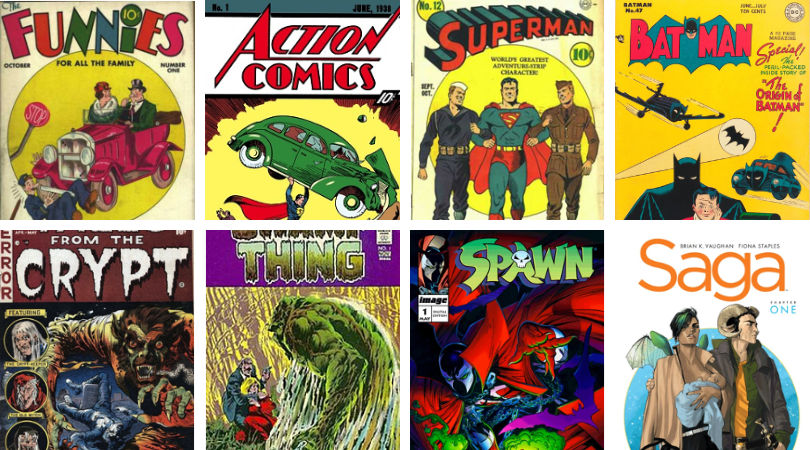This is my history of the comic book industry, and more specifically the North American comic book industry. Although the first comic book ever made was released in Geneva, Switzerland, it didn’t launch the industry as we know it today.
There are six Ages of comics and they are as follows: Victorian Age, Platinum Age, Golden Age, Silver Age, Bronze Age and Modern Age.
Let’s begin.
The Victorian Age (1842–1897)
Unlike other media such as movies, TV and books, we know the first comic ever made was in 1837, Rodolphe Töpffer published his work “Histoire de M. Vieux Bois” or in English “The Adventures of Mr. Obadiah Oldbuck,” in Geneva, Switzerland. The piece became a modern success in Europe, enough to even be bootlegged. The English version of which would be released in the year 1841.




When the story of “The Adventures of Mr. Obadiah Oldbuck” came to America, the newspapers would sample bits and pieces of the work, putting it under a new title, named “Brother Jonathan Extra,” which was a fraudulent and unlicensed version of Rodolphe Töpffer works, and caused a tumble of many unlicensed and bootlegged versions of “The Adventures of Mr. Obadiah Oldbuck” throughout the following years. Continuing “The Adventures of Mr. Obadiah Oldbuck” many other artists and soon-to-be inspiring cartoonists would go on to create their versions of comics and humerus literature, some in the form of magazines, and others in the style of what we now call comic books.
These soon-to-be-called comics (or magazines) were titled, Barker’s Komic Picture Souvenir (1892), Puck (1877), Arm and Hammer Advertisement Booklet (circa the 1800s), Judge (1881), Chip’s Dogs (1895). Even magazines like “Life” got their start from here. Some of these pieces are products of their time, often carrying racist depictions of African Americans and other minorities of the time.
The Platinum Age (1897–1938)
The Platinum Age of comics is mostly responsible for how American comics are made today. Leaving the 19th Century and going into the 20th Century brought a few changes to the comic medium. And that includes the word Itself. The word “Comic” wasn’t used to refer to the medium, until the end of the 19th century when newspapers use d the word, which meant to refer to something humorous, like a comic on stage. And since they were in a long strip format, they called it the “comic strip”. Before this, they were called Funnies.



As demand slowly grew for new original comics and illustrations, newspapers started to notice, eventually leading to the “Funnies” creation. A paper category mainly comprises small comic strips usually telling a story that would only last a few panels at the most. These pages were distributed on Sunday editions to the paper, to maintain readership. This format of comic would be more commonly known as the “daily comic strip”. But of course, they weren’t called that, and they definitely weren’t daily. They were called “comic supplements” and In 1892, William Randolph Hearst published some cartoons in his first newspaper, “The San Francisco Examiner”. These comics cover one newspaper page and were fairly well received. However, The New York World’s best-selling comic would be a little comic called “The Yellow Kid” which was the first to use speech bubbles and a series of panels to create a comic narrative. The character nowadays how however would be considered a little outdated
The Golden Age (1938–1956)
The Golden Age of comics is also the most well-known age. These are where some of the most iconic comic book characters were created, characters such as Batman(1939), Captain Marvel and Shazam(1939), The Flash(1940), Green Lantern(1940), Green Arrow(1941), Wonder Woman(1942), and Atlas’s (also known as Marvel’s) Captain America(1941). But we can’t forget the most well-known Character responsible for starting the Golden Age of comics, Superman(1938).





Action Comics number one was published by Detective Comics (DC for short). Superman Gained wide popularity among young audiences. This success helped comic books become a more important aim for publishers. With Superman’s success came a lot of competitors trying to emulate that success, and so the superhero genre started to gradually become more prevalent in the comic space.
Soon events around the world would start making their way into comics as the year of 1939 would start to approach. As World War II began, many American comics, contributed to the war effort by publishing propaganda to inspire young men to join the military. This of course is where the famous cover of Captain America punching the German dictator “Adolf Hitler” in the face comes from, and this would be the start of Captain America’s rise to fame, from the increasing amount of patriotism in the country.
Though DC hadn’t leaned into the war as hard as Marvel did, they are still guilty of this too.





Entertaining Comics (EC for short) in the 1940s were most well-known for titles retelling historical events and biblical stories in comic form. Still, when Max Gaines passed away his son Willam Gaines decided to take over, and from then on, EC started to publish horror comics. Their most well-known titles being Tales from the Crypt, The Vault of Horror, and The Haunt of Fear. EC is also responsible for creating Mad Magazine, A light-hearted and parody-driven approach to the comic medium at the time.
As the year 1954 approached, something that would affect the comic industry forever was about to happen. A fairly well-known psychiatrist by the name of Fredric Wortham published a book by the name of “Seduction of the Innocent,” which proclaimed that comic books were corrupting children. Many comic book publishers got together to create the Comic Code of Authority (CCA for short). This resulted in pretty much wiping out any comic genre that wasn’t superhero or comedic. EC Choice had no other choice but to cancel all their comic lines except Mad Magazine. This resulted in the comic industries industry being limited as a whole.
The Silver Age (1956–1970)
In the wake of the CCA, publishers and distributors were advised to publish more “Non- violent/vulgar content” resulting in an influx of superhero comics. Superhero comics were the perfect genre for the CCA. They had a basic premise with good guys and bad guys plus they were formulaic allowing unlimited possibilities.
The first major superhero of the Silver Age was The Flash. This era also spawned a group of comics that would collaborate a bunch of the major superheroes into a team. This is what we now know as the “Justice League of America”. This series of comics would contain up to seven of DC’s most popular characters including the Flash, Superman, Aquaman, the Martian Manhunter, Green Lantern, Wonder Woman, and Batman.






But this age of comics was also the rise of Marvel (formally known as Atlas) which was about to publish some of its most well-known titles to this day. In the year 1961 Marvel published “The Fantastic Four”(1960). The following year they would publish a series still famous to this day “Spiderman”(1962). A month later they would publish “The Hulk”(1962). In the proceeding year, they would publish what is still (as of writing this) the most-sold comic ever, “The X-men” (1963) created by Jack Kirby & Stan Lee. Now obviously it didn’t become the most successful comic overnight, that wasn’t until later in its lifetime.
This series of successes would put Marvel on the map, and would soon become a major competitor to DC. The end of the Silver Age started oddly enough with Green Lantern when Julius Schwartz handed over his rights to Green Lantern causing one of the first revisions of a major superhero ever, which led to a decline in sales.
The Bronze Age (1970–1985)
As the rule of the CCA slowly started to relax, The Bronze Age of comics started to tackle more darker and serious themes, such as the “Death of Gwen Stacy” in the Spider-Man comics. Also at this time Jack Kirby, a famous illustrator for Marvel Comics, left the company. Jack Kirby was one if not the best artists in the comic industry. He was famous for getting pages of high-quality art out at lightning speed. There’s a story out there that once said that when an artist, who was working on an issue for Captain America, had failed to meet their deadline, Jack Kirby stepped in and finished the whole issue in a weekend, though this hasn’t been confirmed to be true or not.
The Bronze Age of comics has little contribute in terms of significant changes to the industry. But it definitely would be the age when Marvel started to rule the comic scene. As the likes of Spider-Man, X-Men, The Hulk and The Fantastic Four started to grow in front of the public eye, so did the sales. Marvel’s sales increased day-by-day and were now full-on competitors with DC. As DC kept trucking along, Marvel was catching up. But despite this rivalry, the competitors had a few crossovers, the first of these being Superman and Spiderman. Others were made but none more as notable than that.



Though being known as a manly superhero dominated Age, there were still some notable comics that were outside of the superhero genre and were still popular. These titles were Swamp Thing, Ghost Rider, and spin-offs from movies like Star Wars. The Bronze Age of comics came to an end when DC published, their now-famous comic Crisis on Infinite Earths. This age of comics was somewhat of a safe space for the major comic book publishers. But in the coming years, this narrative would change, as 1985 approached.
The Modern Age (1985–Present)
The Modern Age, also known as the Dark Age of Comics, kicked off with a bang. Alen Moore and Dave Gibbons at DC Comics published Watchman on September 1986, to great commercial and critical success.
The graphic novel was incredibly invasive for the superhero genre and for comics as a whole. during this time it popularized the nine-panel comic page, creating a good sense of motion. It would later be nominated for Best Graphic Album and Best Limited Series cementing Alen Moore and Dave Gibbons as forces to be reckoned with in the comic industry.
Marvel, on the other hand, still had one foot in the Silver Age continuously trying to keep old art styles and remain ahead of the competition.





At this time there were still a few heavy hitters at Marvel, these people were Rob Liefeld, Jim Lee, and Todd McFarlane, who had just gotten off his recent success from the new iterations of Spider-Man. This doesn’t mean Marvel was doing badly; they were doing better than ever in fact. With the release of their widely popular TV shows like X-Men, the Animated series debuting on October 31, 1992, Marvel was on a trail to new heights. But in April 1992, all of the previously named people including Erik Larsen, Marc Silvestri, Jim Valentino and Whilce Portacio, left Marvel and joined together to create Image Comics in the same year. Right off the bat, Todd McFarlane would go on to create his most famous comic to date, “Spawn” debuting only a month later, in May 1992. Erik Larsen would also premiere Savage Dragon’s first full appearance in, “Savage Dragon” issue one in July 1992.
Spawn was an instant success for the image selling well over a million copies in its first month. The image had a few other successes, but it was until much later in the company’s life – successes like Sage (2012) invincible (2003) and The Walking Dead (2003).
And that brings us to today.
Though comics are more relevant today than they were in past generations and the comic industry is worth more than it ever had been, the industry seems to be in a rut with declining sales of new releases. One can only guess how the industry will find its way out of this one. Your guess is as good as mine.
Written by Wes Daniels
Wes is a co-op student with Rrampt
Sources:
Tv Tropes: Useful Notes The Bronze Age Of Comic Books: https://tvtropes.org/pmwiki/pmwiki.php/UsefulNotes/TheBronzeAgeOfComicBooks
PBS: The Golden Age Of Comics: https://www.pbs.org/opb/historydetectives/feature/the-golden-age-of-comics/#:~:text=Comics%20have%20been%20in%20existance,launch%20of%20Superman%20in%201938.













